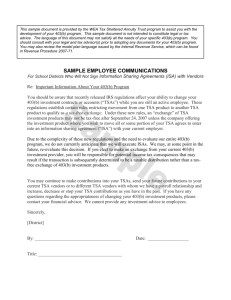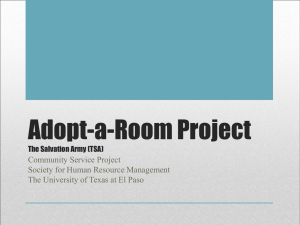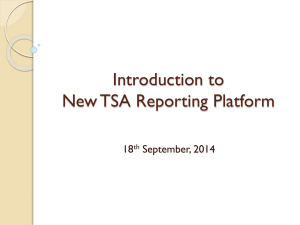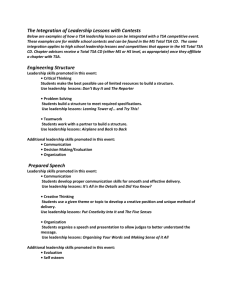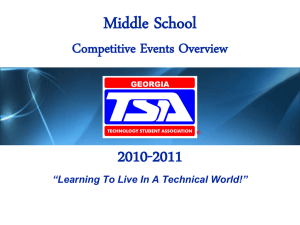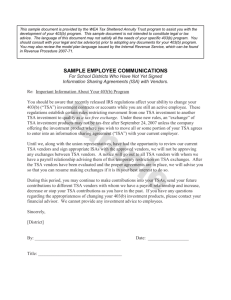software development
advertisement
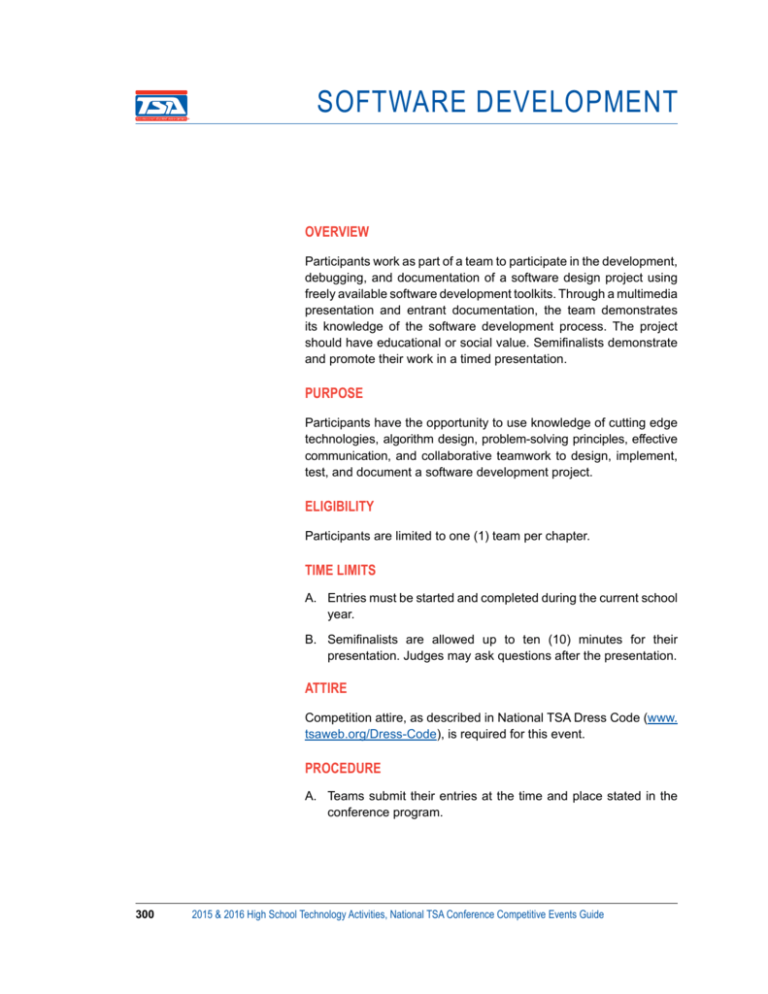
SOFTWARE DEVELOPMENT OVERVIEW Participants work as part of a team to participate in the development, debugging, and documentation of a software design project using freely available software development toolkits. Through a multimedia presentation and entrant documentation, the team demonstrates its knowledge of the software development process. The project should have educational or social value. Semifinalists demonstrate and promote their work in a timed presentation. PURPOSE Participants have the opportunity to use knowledge of cutting edge technologies, algorithm design, problem-solving principles, effective communication, and collaborative teamwork to design, implement, test, and document a software development project. ELIGIBILITY Participants are limited to one (1) team per chapter. TIME LIMITS A. Entries must be started and completed during the current school year. B. Semifinalists are allowed up to ten (10) minutes for their presentation. Judges may ask questions after the presentation. ATTIRE Competition attire, as described in National TSA Dress Code (www. tsaweb.org/Dress-Code), is required for this event. PROCEDURE A. Teams submit their entries at the time and place stated in the conference program. 300 2015 & 2016 High School Technology Activities, National TSA Conference Competitive Events Guide Software Development B. Entries are reviewed by evaluators. Neither students nor advisors are present at this time. A semifinalist list in random order is posted. C. Semifinalist teams report to the event area at the time and place stated in the conference program. D. No more than three (3) team members will be allowed to be present during the presentation. Semifinalist teams give a presentation that showcases their team’s work on their project and promotes the project to potential users. Teams also give a demonstration of their project. Evaluators are free to ask questions. E. No more than two (2) team members of the team pick up the entry from the display area at the time and place stated in the conference program. REGULATIONS A. A presentation CD/DVD and documentation materials are submitted at check-in. Documentation materials (comprising a “portfolio”) are required and should be secured in a clear front report cover. The report cover must include the following singlesided, 8½" x 11" pages, in this order: 1. Title page with the event title, the conference city and state, and the year; one (1) page 2. Table of contents; pages as needed 3. Research about the problem; one (1) page 4. Description of the team’s project, including the problem and the solution for the problem, and an explanation of the project’s social or educational value; up to two (2) pages 5. Plan of Work log that indicates preparation for the event, as noted by date, task, time involved, team member(s) responsible, and comments (See Plan of Work log); one (1) page 6. Documentation of the use of a software development process, including the following: a. Project requirements; one (1) page b. High-level software design; one (1) page c. Testing, including code output and desired results; pages as needed d. End-user product documentation; pages as needed 7. Team’s evaluation of its work and the project’s future prospects; one (1) page 8. List of references used for the project 2015 & 2016 High School Technology Activities, National TSA Conference Competitive Events Guide 301 Software Development 9. The CD/DVD (in a CD/DVD sleeve) attached to a sheet of paper in the portfolio. The team ID# must be indicated on the CD/DVD. B. The CD/DVD should include the following: 1. A copy of the multimedia presentation 2. Project source code 3. Runnable, compiled program C. All portfolios and presentations become the property of TSA, Inc., and will not be returned after the event. EVALUATION Evaluation is based on the quality of work and overall benefit showcased in the participant portfolio. Semifinalists will be judged on their multimedia presentation and their ability to promote their software project, both to expand end-user usage and attract future developers. See the official rating form for more information. 302 2015 & 2016 High School Technology Activities, National TSA Conference Competitive Events Guide Software Development STEM INTEGRATION This event aligns with the STEM educational standards noted below. Please refer to the STEM Integration section of this guide for more information. Science, Technology, Engineering, Mathematics COMMON CORE STATE STANDARDS (CCSS) INTEGRATION Please refer to the Common Core State Standards (CCSS) Integration section of this guide for more information. PRIMARY LEADERSHIP SKILLS Leadership skills promoted in this event: • • • COMMUNICATION ― Students communicate with team members and other project developers, debuggers, and documenters. Suggested leadership lessons: Fact Or Fiction and Promote It CRITICAL THINKING ― Students analyze and evaluate a problem in order to arrive at an acceptable solution. Suggested leadership lessons: And the Answer Is and Figure It Out PROBLEM SOLVING ― Students design solutions to problems within open source software. Suggested leadership lessons: Debate It and Effective Brainstorming Additional leadership skills promoted in this event: self-esteem, teamwork, organization, decision making, ethics, creative thinking, evaluation TSA AND CAREERS This competition connects to one or more of the career areas featured in the TSA AND CAREERS section of this guide. Use The 16 Career Clusters chart and the TSA Competitions and The 16 Career Clusters grid as resources for information about careers. CAREERS RELATED TO THIS EVENT Graphic designer Software engineer 2015 & 2016 High School Technology Activities, National TSA Conference Competitive Events Guide 303 Software Development TECHNOLOGY STUDENT ASSOCIATION PLAN OF WORK Date Task 1 ____________ 2 ____________ 3 ____________ 4 ____________ 5 ____________ 6 ____________ __________________ __________________ __________________ __________________ __________________ __________________ Time involved Team member responsible Comments ________ __________________ __________________ __________________ ____________ __________________ ________ __________________ __________________ __________________ ____________ __________________ ________ __________________ __________________ __________________ ____________ __________________ ________ __________________ __________________ __________________ ____________ __________________ ________ __________________ __________________ __________________ ____________ __________________ ________ __________________ __________________ __________________ ____________ __________________ Advisor signature _______________________________________________ 304 2015 & 2016 High School Technology Activities, National TSA Conference Competitive Events Guide Software Development SOFTWARE DEVELOPMENT EVENT COORDINATOR INSTRUCTIONS PERSONNEL A. Event coordinator B. Evaluators for portfolios, two (2) or more C. Evaluators for semifinalist presentations, two (2) or more MATERIALS A. Coordinator’s notebook, containing: 1. Event guidelines, one (1) copy for the coordinator and for each evaluator 2. Official rating forms 3. List of entries with finalist report 4. List of evaluators/assistants 5. Pens for evaluators 6. Semifinalist list for posting 7. Results envelope B. Chairs, as needed for judging C. Stopwatch for timing semifinalist presentations D. Laptop computer for the semifinalist presentation RESPONSIBILITIES A. Upon arrival at the conference, report to the CRC room and check the contents of the coordinator’s notebook. Review the event guidelines and check to see that enough evaluators/ assistants have been scheduled. B. Inspect the area(s) in which the event is being held for appropriate set-up, including room size, chairs, tables, outlets, etc. Notify the event manager of any potential problems. C. One (1) hour before the event is scheduled to begin, meet with your evaluators/assistants to review time limits, procedures, and regulations. If questions arise that cannot be answered, speak to the event manager before the event begins. D. Check in the entries at the time stated in the conference program. Anyone reporting who is not on the entry list may check in only after official notification is received from the CRC chairperson. Late entries are considered on a case-by-case basis and only 2015 & 2016 High School Technology Activities, National TSA Conference Competitive Events Guide 305 Software Development when the lateness is caused by events beyond the participant’s control. Requirements for attire do NOT apply during check-in. E. Place an entry number on each presentation CD/DVD and portfolio. Position entries for evaluation and viewing by judges. Secure the entries in the designated area. F. Evaluators independently review each entry and complete the official rating form. G. For participants who violate the rules, the decision either to deduct 20% of the total possible points or to disqualify the entry must be discussed and verified with the evaluators, event coordinator, and a CRC manager; all must initial either of these actions on the rating form. H. Evaluators average their scores to determine the twelve (12) semifinalists. I. Prepare a list of the twelve (12) semifinalists in random order and submit it to the CRC chairperson for posting. J. Inspect the area in which the semifinalist presentations are to be held. There must be seating for at least five (5) people at a table that has been set up with a computer and display. K. Meet with your semifinalist evaluators to review time limits, procedures, and regulations. If questions arise that cannot be answered, speak to the event manager before the event begins. L. Conduct semifinalist presentations/interviews. should be sure to ask questions. Evaluators M. Evaluators average their scores to determine the ranking of the ten (10) finalists. Evaluators discuss and break any ties. N. Complete and submit the finalist report, which includes a ranking of the ten (10) finalists, and all related forms in the results envelope to the CRC room. O. Manage security and the removal of materials from the area. 306 2015 & 2016 High School Technology Activities, National TSA Conference Competitive Events Guide Software Development Participant/Team ID# _________________________________ SOFTWARE DEVELOPMENT HIGH SCHOOL Documentation (50 points) CRITERIA Minimal performance Adequate performance Exemplary performance 1-4 points 5-8 points 9-10 points Evaluators: Using minimal (1-4 points), adequate (5-8 points) or exemplary (9-10 points) performance levels as a guideline, record the scores earned for the event criteria in the column spaces to the far right. The X1 or X2 notation in the criteria column is a multiplier factor for determining the points earned. (Example: an “adequate” score of 7 for an X1 criterion = 7 points; an “adequate” score of 7 for an X2 criterion = 14 points.) Portfolio components The portfolio is unorganized and/or is missing three or more components. The portfolio is somewhat organized; it may be missing one or two components. The portfolio is organized and complete and includes all required components. Research The research is inadequate, and/ or very few credible sources are referenced. The research is adequate, with credible sources included. The research is comprehensive, and credible resources are included. Description of project A description of the project, including an explanation of the problem and the solution for the problem, is poorly presented; many grammatical errors are present. A description of the project adequately addresses the problem and its solution; some grammatical errors may be present. The description of the project is clear and concise and fully addresses the problem and solution; there are no or few grammatical errors present. Plan of Work log and self-evaluation The Plan of Work log and the selfevaluation are incomplete and/or missing key components; there are a number of grammatical errors. The Plan of Work log and selfevaluation are mostly complete and adequately written. The Plan of Work log and the self-evaluation are complete and concisely written; they include the reflections of all team members. Multimedia presentation The multimedia presentation adds little understanding to the project. The multimedia presentation somewhat enhances the understanding of the project. The multimedia presentation is effective and significantly enhances understanding of the project. See Regulation A (X1) (X1) (X1) (X1) (X1) SUBTOTAL (50 points) Software Design (60 points) CRITERIA Minimal performance 1-4 points Adequate performance 5-8 points Exemplary performance 9-10 points Software coding practices The project developed does not follow general software coding practices (requirements, design, implementation, and testing). The project developed follows most general software coding practices (requirements, design, implementation, and testing). The excellent projected developed follows all general software coding practices (requirements, design, implementation, and testing). Complexity The software design exhibits little complexity; it appears as a “bare bones” effort. The software design exhibits some degree of complexity. The software design is complex, resulting in a highly functional product. Creativity The work lacks creativity; very little original thought in developing the project is evident. Some elements of creativity are expressed; the solution is somewhat original. The work exudes creativity; the product is highly original. Technical skill Little technical skill is exhibited in the software; levels of software design and development do not flow and/or are illogical. A beyond-basic degree of technical skill is exhibited in the software’s design and construction; the software flows somewhat effectively from level to level. A significant level of mastery of software design skill is exhibited; the software flow is constant and logical. (X2) (X1) (X1) (X1) 2015 & 2016 High School Technology Activities, National TSA Conference Competitive Events Guide 307 Record scores in the column spaces below. 2015 & 2016 OFFICIAL RATING FORM Software Development SOFTWARE DEVELOPMENT (continued) Software Design (60 points) (continued) Effectiveness The software design does not appropriately provide a solution to the intended problem. (X1) The design loosely provides a solution to the intended problem and somewhat addresses the problem presented. The solution to the problem is clear in the software design; the solution is at the forefront of software creation. SUBTOTAL (60 points) Rules violations (a deduction of 20% of the total possible points) must be initialed by the evaluator, coordinator, and manager of the event. Record the deduction in the space to the far right. Indicate the rule violated: __________ Presentation (60 points) CRITERIA Minimal performance Adequate performance 1-4 points 5-8 points Exemplary performance 9-10 points Organization The team seems unprepared and unorganized for the presentation and interview. The team is prepared and adequately organized in its presentation to judges. The team’s presentation is logically organized and effectively presented. Knowledge Team members seem to have very little understanding of the concepts in their project; they provide vague interview answers. All team members have a general understanding of the concepts discussed and answer questions adequately. There is clear evidence that all team members have a thorough understanding of the concepts presented in their project. Articulation The team’s presentation is full of illogical thoughts that lack understanding and clarity. The team’s presentation is logical, with most points clearly explained. The team provides a concise, logical and clear explanation of the thesis and pertinent issues. Delivery The presenters are verbose and illogical in the presentation; many “uhs, ums, hmms,” etc., are used. Logical and well-spoken interview responses are evident, with few “uhs, ums, hmms,” etc. Team members are well spoken and distinct; clear interview responses are given, with very few, if any, “uhs, ums, hmms,” etc. Team participation Only one team member communicates with judges; there is no participation from other team members. Team members participate equally, and most seem to fully understand the concepts. All team members seem to fully understand the concepts and share an equal role in the presentation. Software demonstration Team members are unable to successfully demonstrate their software product. Team members are able to adequately demonstrate the functionality of their software product. Team members are highly successful and effective in their project demonstration. (X1) (X1) (X1) (X1) (X1) (X1) SUBTOTAL (60 points) 308 2015 & 2016 High School Technology Activities, National TSA Conference Competitive Events Guide Software Development SOFTWARE DEVELOPMENT (continued) Rules violations (a deduction of 20% of the total possible points) must be initialed by the evaluator, coordinator, and manager of the event. Record the deduction in the space to the far right. Indicate the rule violated: __________ (To arrive at TOTAL score, add any subtotals and subtract rules violation points, as necessary. Check your math twice!) TOTAL (170 points) Comments: I certify these results to be true and accurate to the best of my knowledge. Evaluator Printed name: _______________________________________ Signature: ________________________________________________ 2015 & 2016 High School Technology Activities, National TSA Conference Competitive Events Guide 309
